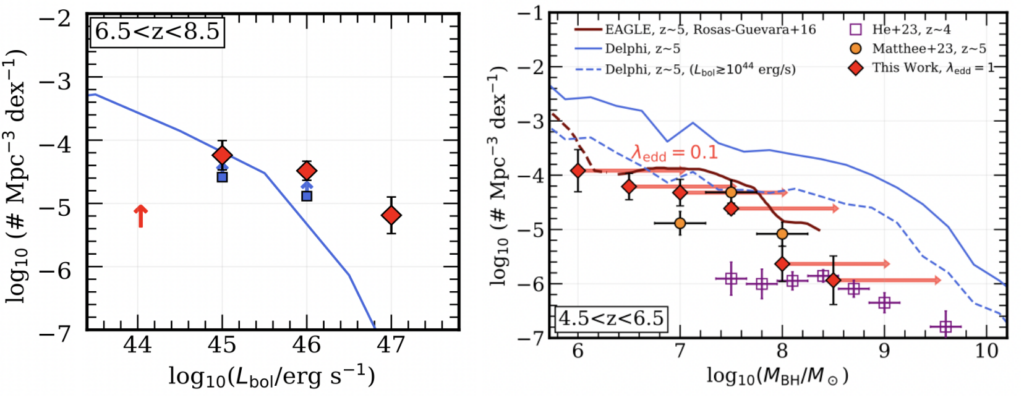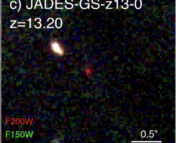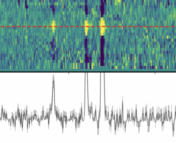Title: A Census of Photometrically Selected Little Red Dots at 4 < z < 9 in JWST Blank Fields
Authors: Vasily Kokorev, Karina I. Caputi, Jenny E. Greene, Pratika Dayal, Maxime Trebitsch, Sam E. Cutler, Seiji Fujimoto, Ivo Labbé, Tim B. Miller, Edoardo Iani, Rafael Navarro-Carrera, and Pierluigi Rinaldi
First Author’s Institution: Kapteyn Astronomical Institute, University of Groningen, 9700 AV Groningen, The Netherlands
Status: Submitted to the Astrophysical Journal Letters [open access]
Imagine you peek into a kindergarten class and, to your shock, you see all the children are well over 6 feet tall. That is precisely how astronomers felt when data from the James Webb Space Telescope (JWST) showed galaxies with massive black holes just a few million years after the birth of the universe. Some of these black holes have been measured to be a million times more massive than the mass of our sun, and astronomers are puzzled as to how they could have gained so much mass in such a relatively short time.
The earliest galaxies likely to host these black holes show up as little red dots (LRDs) in the images JWST took of the early universe (as seen in the long exposure images; see the bottom image in Figure 1). They are believed to be compact (with a small radius) galaxies with a type 1 AGN and obscured (covered by dust), which accounts for their red color and why they are easily observed in the infrared. The spectrum of the galaxy has a ‘V’ shape, a blue continuum from the unobscured part of the AGN in the galaxy, and a red continuum from the obscured AGN (See Figure 1). These red dots have appeared in several images of the early universe taken by JWST, hinting that plenty of these massive black holes are lurking in the early universe.

Where you look matters!
It is vital to systematically look at these LRDs to understand how many massive black holes were in the early universe. Two factors can induce probable biases in the counting of these galaxies. One is the phenomenon of cosmic variance: Is JWST just preferentially looking in a direction with many LRDs, or should we expect the same number even when it looks at different parts of the universe? The other is how crowded it is in the direction in which you are observing. If you have a lot of stars in the direction you are looking, they could be misclassified as LRDs or vice versa. If you happen to have plenty of massive galaxy clusters in the direction you are looking, they may create an illusion that more of these LRDs exist than their true numbers (a phenomenon known as gravitational lensing).
To minimize the errors caused by these effects in determining the number of LRDs in the early universe, the authors of today’s paper specifically look at large areas (337 arcminutes) in the sky by combining JWST data from various programs. This would minimize the effects of cosmic variance as you can measure the numbers over a bigger area of the sky. They also look specifically at data in blank fields (defined here as areas on the sky without galaxy clusters) which helps them determine the accurate number of objects per unit volume. All these galaxies are photometrically selected (i.e., chosen only from looking at images rather than spectra), meaning there is limited spectroscopic data to help confirm what kind of object it is. Galaxies are determined to be LRDs based on how compact they are in the images and their red colors. Using the obtained fluxes, the authors then construct Spectral Energy Distribution (SEDs) to determine the redshifts (z) of the sample. Limiting the sample to z > 4 (for the early universe), the authors end up with 260 LRDs.
Do not judge a galaxy by its size (in your JWST image!)
On calculating the total luminosity of the LRDs and comparing it to the redshifts, the authors find a large number of bright LRDs (almost 100 times more than ultraviolet selected quasars, which is another method to identify AGN) at redshift 5 (around a billion years after the beginning of the universe). They also find that computer models are unable to reproduce the high fraction of the bright galaxies they uncover at high redshifts (Figure 2a). The authors derive the mass of the black holes (around 106 – 108 M☉) at redshifts 4.5 – 6.5, indicating that these black holes were already massive a few hundred million years after the Big Bang. They find deviations from the predicted number densities of massive black holes at these redshifts from galaxy simulations. This is likely because the galaxies that host more gigantic black holes are very dusty, and thus, their spectrum does not have any blue continuum. They may then be missed from selections of LRDs as one of the factors it depends on is the characteristic ‘V’ shaped spectrum, which would need a contribution from the blue continuum (Figure 2b).

While spectroscopy is the more reliable method to identify massive black holes, many galaxies that host black holes can still be picked out using near-infrared colors and photometry, which is much less expensive. The challenge lies in ensuring that the photometrically selected sources are reliable, and the authors of today’s paper made great use of this technique. Follow-up spectroscopic studies of these photometrically selected samples can help us further understand the exact nature of the black holes. Such studies are already underway, and we can look forward to finally making sense of how these black holes became so massive in such a short time after the formation of the universe!
Astrobite edited by Delaney Dunne
Featured image credit: NASA




